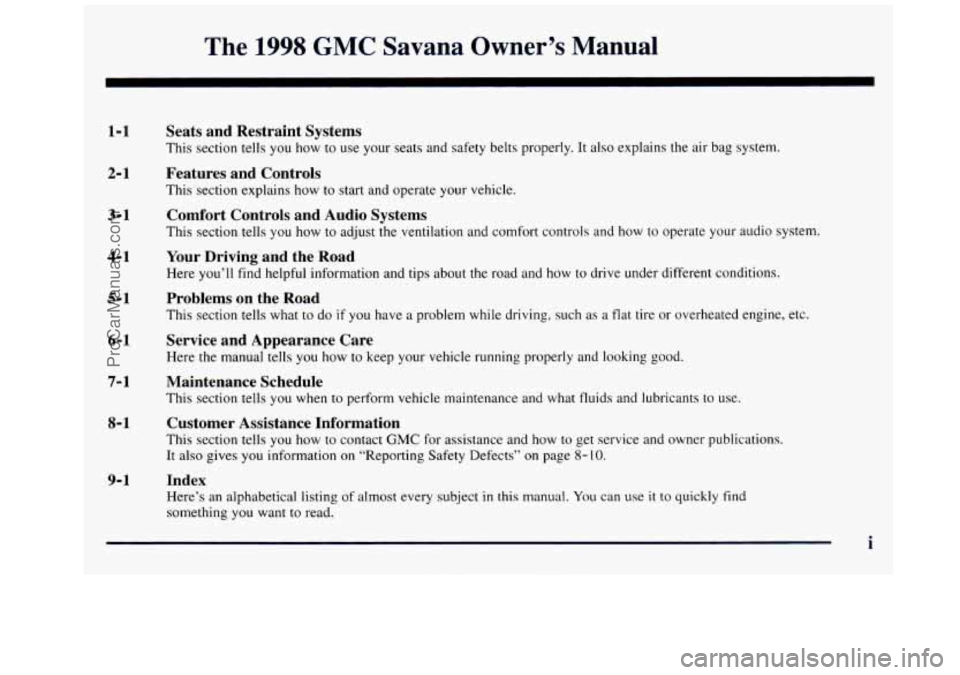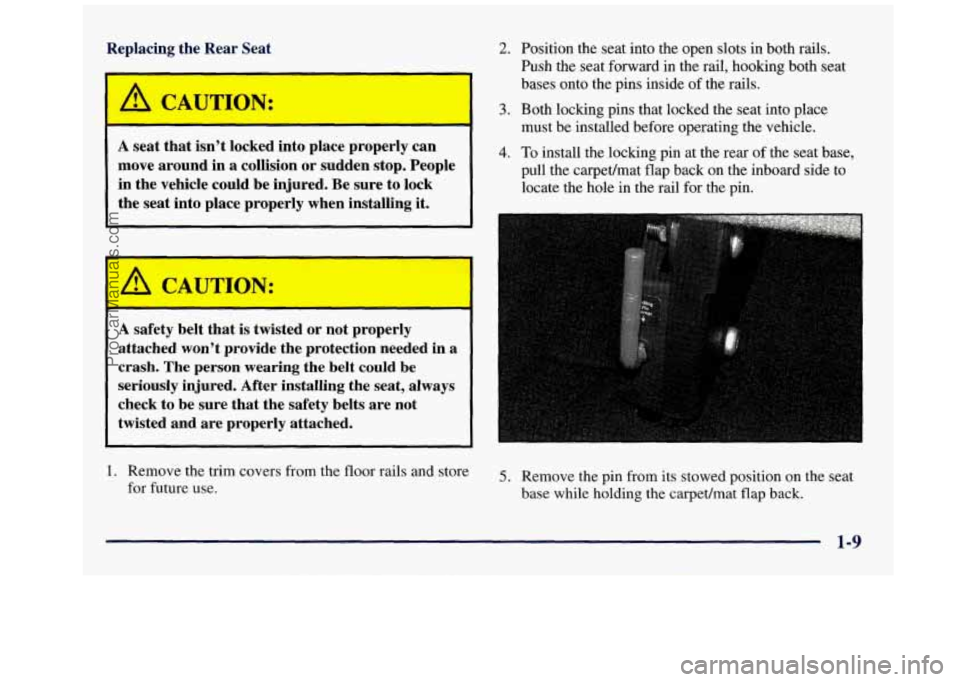Page 3 of 388

The 1998 GMC Savana Owner’s Manual
1-1
2- 1
3-1
4-1
5-1
6-1
7- 1
8- 1
9-1
Seats and Restraint Systems
This section tells you how to use your seats and safety belts properly. It also explains the air bag system.
Features and Controls
This section explains how to start and operate your vehicle.
Comfort Controls and Audio Systems
This section tells you how to adjust the ventilation and comfort controls and how to operate your audio system.
Your Driving and the Road
Here you’ll find helpful information and tips about the road and how to drive under different conditions.
Problems on the Road
This section tells what to do if you have a problem while driving, such as a flat tire or overheated engine, etc.
Service and Appearance Care
Here the manual tells you how to keep your vehicle running properly and looking good.
Maintenance Schedule
This section tells you when to perform vehicle maintenance and what fluids and lubricants to use.
Customer Assistance Information
This section tells you how to contact GMC for assistance and how to get service and owner publications.
It
also gives you information on “Reporting Safety Defects” on page 8- 10.
Index
Here’s an alphabetical listing of almost every subject in this manual. You can use it to quickly find
something
you want to read.
i
ProCarManuals.com
Page 7 of 388
Vehicle Symbols
These are some of the symbols you may find on your vehicle.
For example,
these symbols
are used on
an
original battery:
POSSIBLE A
CAUTION
INJURY
PROTECT EYES BY
SHIELDING
CAUSTIC
BAlTERY
CAUSE
BURNS
ACID COULD
&
AVOID
SPARKS
OR
FLAMES
SPARK
OR ,\I/,
COULD FLAME
EXPLODE BATTERY
These symbols are important
for you and
your passengers whenever your
vehicle is
driven:
DOOR LOCK
UNLOCK
FASTEN SEAT
BELTS
These symbols have
to do with
your lamps:
SIGNALS e e
TURN
FOG LAMPS
$0
These symbols
are on some
of
your controls:
WINDSHIELD
WIPER
WINDSHIELD DEFROSTER
WINDOW
DEFOGGER
VENTILATING FAN
These symbols are used
on
warning and
indicator
lights:
COOLANT -
TEMP -
CHARGING l=l
BATTERY
SYSTEM
BRAKE
(0)
COOLANT a
ENGINE OIL e,
PRESSURE
ANTI-LOCK
(@)
BRAKES
Here are some
other symbols
you may
see:
FUSE -%-
P
LIGHTER m
HORN )cr
SPEAKER
b
FUEL p3
V
ProCarManuals.com
Page 9 of 388
Section 1 Seats and Restraint Systems
Here you’ll find information about the seats in your vehicle\
and how to use your safety belts properly. You can also
learn about some things you should
not do with air bags and safety belts.
1-2 1-11
1-16
1- 17
1-17
1-25
1-26
1-26 1-34 Seats and Seat Controls
Safety Belts: They’re for Everyone
Here Are Questions Many People Ask About Safety Belts
-- and the Answers
How to Wear Safety Belts Properly
Driver Position Safety Belt Use During Pregnancy
Right Front Passenger Position
Air Bag System
Rear Seat Passengers 1-37
1-39
1-41
1-46
1-58 1-61
1-61
1-62 Rear Safety Belt Comfort Guides for Children
and Small Adults
Center Passenger Position
Children Child Restraints
Larger Children
Safety Belt Extender
Checking Your Restraint Systems
Replacing Restraint System Parts After
a Crash
ProCarManuals.com
Page 12 of 388
But don’t have a seatback reclined if your vehicle
is moving.
A CAUTION:
Sitting in a reclined position when your vehicle is
in motion can be dangerous. Even if you buckle
up, your safety belts can’t do their job when
you’re reclined like this.
The shoulder belt can’t do its job because it
won’t be against your body. Instead, it will be in
front of you. In
a crash you could go into it,
receiving neck
or other injuries.
The lap belt can’t do its job either. In a crash the
belt could go up over your abdomen. The belt
forces would be there, not at your pelvic bones.
This could cause serious internal injuries.
For proper protection when the vehicle is in
motion, have the seatback upright. Then sit well
back in the seat and wear your safety belt properly.
1-4
ProCarManuals.com
Page 13 of 388
Rear Seats
Getting Into the Rear Seats
To make it easier for passengers to get into the rear
seats, use the fastener strips on the headliner
and safety
belt latch. These will keep the safety belts out
of the way
while people get into the rear seats.
1-5
ProCarManuals.com
Page 14 of 388
Removing the Rear Seat
1. Disconnect the quick release latch plates for the lap
shoulder belts
on the bench seat to be removed. To
do this, press the tip of a key into the release hole
of the safety belt buckle while pulling up on the
safety belt.
2. Lift the carpet/mat flap at the inboard side of the seat
base
in the rear.
1-6
ProCarManuals.com
Page 16 of 388
10. For the first rear seat, stow the safety belt latch by
attaching the fastener strip on the safety belt latch
to the trim just inside
the side door. There is also a
fastener strip provided for stowing the safety belt
latch for
a four-passenger bench seat, if equipped. For the remaining rear
seats, stow the safety belt
latch plate
on the clip at the window trim.
1-8
ProCarManuals.com
Page 17 of 388

Replacing the Rear Seat
~~
/1 CAUTION.
A seat that isn’t locked into place properly can
move around in a collision or sudden stop. People
in the vehicle could be injured. Be sure to lock
the seat into place properly when installing it.
A safety belt that is twisted or not properly
attached won’t provide the protection needed in a
crash. The person wearing the belt could be
seriously injured. After installing the seat, always
check to be sure that the safety belts are not
twisted and are properly attached.
2. Position the seat into the open slots in both rails.
Push the seat forward in the
rail, hooking both seat
bases onto the pins inside of the rails.
3. Both locking pins that locked the seat into place
must be installed before operating the vehicle.
4. To install the locking pin at the rear of the seat base,
pull the carpetlmat flap back on the inboard side to
locate the hole in the rail for the pin.
1. Remove the trim covers from the floor rails and store
for future use. 5. Remove the pin from its stowed position on the seat
base while holding the carpetlmat flap back.
ProCarManuals.com